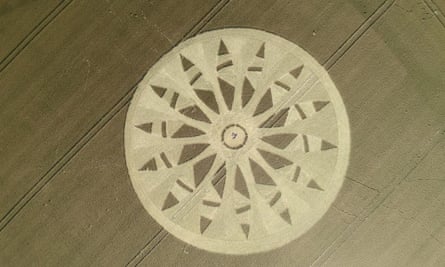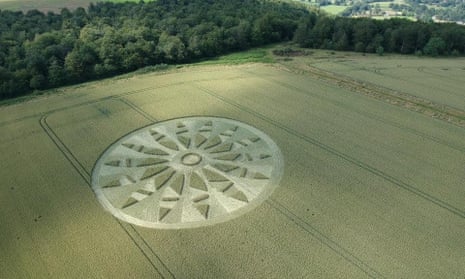More than 40 football pitches’ worth of arable land has been affected by crop circles in England since 2018, according to an analysis carried out by the Guardian.
Farmers lost £30,000 in income between 2018 and 2022 as a result of 92 crop circles of varying sizes. The wheat and barley lost over the period could have made 300,000 loaves of bread, and the flattened rapeseed could have produced 600 litres of canola oil.
Crop circles have come under particular scrutiny this year for the unwelcome toll they are taking on farmers’ harvests at a time of global food crisis. Grain prices have surged since Russia invaded Ukraine in February, with both countries major suppliers of crops to the global markets.
The price per tonne of wheat on London future markets has jumped 30% since 2021, while barley’s price has gone up by almost 40% – making crop circles substantially more damaging to farmers’ wallets.
“They wiped out all of the wheat, around three or four tonnes of it,” said George Hosford, a tenant farmer in North Dorset.
Hosford woke up on 18 July 2021 to find a crop circle had been created overnight in one of his fields, measuring 70m in diameter and with seven points of symmetry.

“Of course, I don’t believe this rubbish that it’s done by aliens,” Mr Hosford told the Guardian. “Funnily enough, pictures of the circle were up on the internet within hours.
“Yet it was in a really remote position. It couldn’t be overseen from anywhere aside from a small patch of my neighbour’s land – he was the one who pointed it out to me,” Hosford explained.
“It’s done by people using ropes, boards and ladders to flatten parts of the crop – and usually in wheat, because it’s fine and upstanding. Barley, on the other hand, leans a lot, so the patterns don’t look as neat.”
Hosford estimates he lost about £1,000 in income due to the crop circle. He has already spent almost £200 on fertiliser, seeds and other operational costs for the damaged patch.
After crop circles are created, sightseers often further exacerbate the damage by entering the field and trampling over the untouched parts. The locations of circles are usually listed on websites for enthusiasts.
Although “circle makers” do not generally damage the grains by squashing them down, harvesting the affected areas becomes close to impossible.
Hosford explained that combine harvesters cannot cut below 15 centimetres of the ground.
“Otherwise, you scrape up soil and stones and you wreck the machine,” he said.
Farmers afflicted by crop circles have little recourse, with their insurance excess fees often too high to make claiming worthwhile.
Hosford said he did not report the July crop circle to police as he had the impression that it would not have been taken seriously.
Although 15 crop circles covered about 55,000 square metres of grain in Wiltshire between 2021 and 2022, police in the area received only three reports of criminal damage relating to these incidents, according to data obtained under freedom of information requests.
Crop circles disproportionately affect farmers in Wiltshire, with 63% of all recorded incidents since 2018 having occurred in the county.
Patty Greer, a crop circle researcher from Colorado in the US, told The Guardian: “Wiltshire has been the epicentre of documented crop circle appearances for the last 40 years.
“Many crop circles have been located near the Avebury Stone Circle, Stonehenge and Glastonbury. Almost all documented crop circles are located on a ley line, which is a direct line between two sacred sites on a map,” said Greer.
Neighbouring Hampshire is also a popular location for circle creators, and has been the site of 27% of England’s recorded crop circles since 2018. The remaining 10% of incidents were spread between Dorset, Gloucestershire, Oxfordshire, Somerset, Surrey and Warwickshire.
